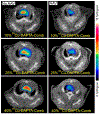Chemokine receptor PET imaging: Bridging molecular insights with clinical applications
- PMID: 38691942
- PMCID: PMC11180593
- DOI: 10.1016/j.nucmedbio.2024.108912
Chemokine receptor PET imaging: Bridging molecular insights with clinical applications
Abstract
Chemokine receptors are important components of cellular signaling and play a critical role in directing leukocytes during inflammatory reactions. Their importance extends to numerous pathological processes, including tumor differentiation, angiogenesis, metastasis, and associations with multiple inflammatory disorders. The necessity to monitor the in vivo interactions of cellular chemokine receptors has been driven the recent development of novel positron emission tomography (PET) imaging agents. This imaging modality provides non-invasive localization and quantitation of these receptors that cannot be provided through blood or tissue-based assays. Herein, we provide a review of PET imaging of the chemokine receptors that have been imaged to date, namely CXCR3, CXCR4, CCR2, CCR5, and CMKLR1. The quantification of these receptors can aid in understanding various diseases, including cancer, atherosclerosis, idiopathic pulmonary fibrosis, and acute respiratory distress syndrome. The development of specific radiotracers targeting these receptors will be discussed, including promising results for disease diagnosis and management. However, challenges persist in fully translating these imaging advancements into practical therapeutic applications. Given the success of CXCR4 PET imaging to date, future research should focus on clinical translation of these approaches to understand their role in the management of a wide variety of diseases.
Keywords: Chemokine receptors; Clinical translation; Diagnostic tools; PET imaging; Radiotracer development.
Copyright © 2024 Elsevier Inc. All rights reserved.
Conflict of interest statement
Declaration of competing interest The authors declare that they have no known competing financial interests or personal relationships that could have appeared to influence the work reported in this paper.
Figures












Similar articles
-
Health professionals' experience of teamwork education in acute hospital settings: a systematic review of qualitative literature.JBI Database System Rev Implement Rep. 2016 Apr;14(4):96-137. doi: 10.11124/JBISRIR-2016-1843. JBI Database System Rev Implement Rep. 2016. PMID: 27532314
-
AGA Clinical Practice Update on GI Manifestations and Autonomic or Immune Dysfunction in Hypermobile Ehlers-Danlos Syndrome: Expert Review.Clin Gastroenterol Hepatol. 2025 Jul;23(8):1291-1302. doi: 10.1016/j.cgh.2025.02.015. Epub 2025 May 19. Clin Gastroenterol Hepatol. 2025. PMID: 40387691 Review.
-
Assessing the comparative effects of interventions in COPD: a tutorial on network meta-analysis for clinicians.Respir Res. 2024 Dec 21;25(1):438. doi: 10.1186/s12931-024-03056-x. Respir Res. 2024. PMID: 39709425 Free PMC article. Review.
-
Relationship between Pituitary Gland and Stem Cell in the Aspect of Hormone Production and Disease Prevention: A Narrative Review.Endocr Metab Immune Disord Drug Targets. 2025;25(7):509-526. doi: 10.2174/0118715303314551241031093717. Endocr Metab Immune Disord Drug Targets. 2025. PMID: 39812047 Review.
-
How to Implement Digital Clinical Consultations in UK Maternity Care: the ARM@DA Realist Review.Health Soc Care Deliv Res. 2025 May;13(22):1-77. doi: 10.3310/WQFV7425. Health Soc Care Deliv Res. 2025. PMID: 40417997 Review.
Cited by
-
CXCR4-targeted theranostics in acute leukemia: disrupting leukemic cell-microenvironment interactions with pentixafor and pentixather.Med Oncol. 2025 Aug 4;42(9):402. doi: 10.1007/s12032-025-02924-w. Med Oncol. 2025. PMID: 40754635 Review.
References
-
- Zlotnik A and Yoshie O (2000). “Chemokines: a new classification system and their role in immunity.” Immunity 12(2): 121–127. - PubMed
-
- Murphy PM (2001). “Chemokines and the molecular basis of cancer metastasis.” N Engl J Med 345(11): 833–835. - PubMed
-
- Thelen M and Stein JV (2008). “How chemokines invite leukocytes to dance.” Nat Immunol 9(9): 953–959. - PubMed
Publication types
MeSH terms
Substances
Grants and funding
LinkOut - more resources
Full Text Sources

